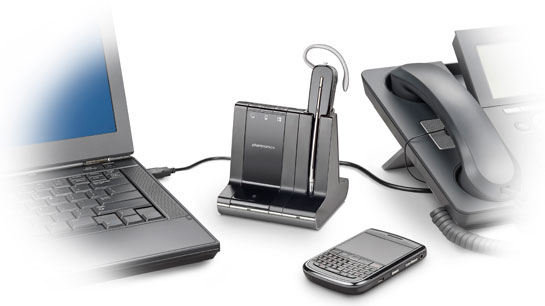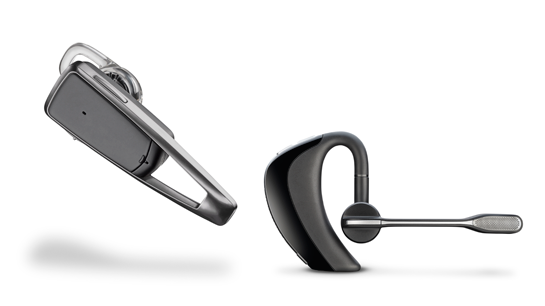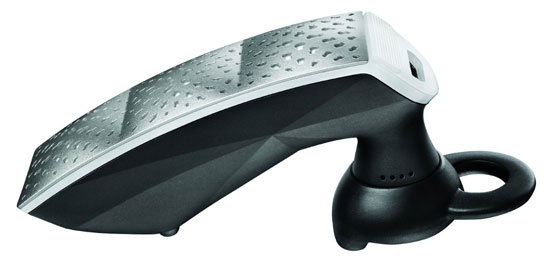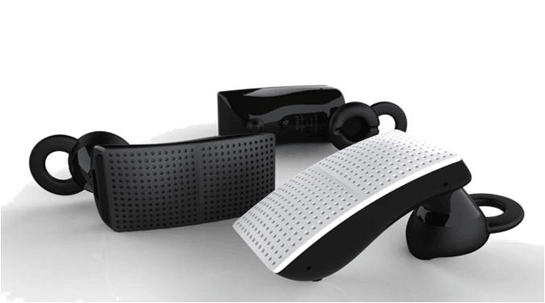 The more phones you have in your life, the more you might be interested in Plantronics’ Savi 700 series of wireless headsets, which the company announced today. Unlike most headsets, the new Savis are designed to be used with mobile phones (via Bluetooth), work landlines, and PC-based VoIP services–and to let you roam between them, with a range of up to 350 feet.
The more phones you have in your life, the more you might be interested in Plantronics’ Savi 700 series of wireless headsets, which the company announced today. Unlike most headsets, the new Savis are designed to be used with mobile phones (via Bluetooth), work landlines, and PC-based VoIP services–and to let you roam between them, with a range of up to 350 feet.
Tag Archives | Headsets
Jawbone's New Era of Bluetooth Headsets
Almost exactly one year after releasing the stylish Jawbone Icon, Bluetooth headset maker Aliph is back with the Jawbone Era, a new $129 model that’s meant as a higher-end complement to the $99 Icon, which remains on the market. It continues to address my own long-standing gripe about all headsets–I can never remember how to use the darn things–by being the first model I’ve seen that you can operate without using any buttons other than the on/off switch.
Aliph VP Travis Bogard provided me with an Era for review and told me that the headset was also designed for an, um, era in which relatively few people choose to use a Bluetooth headset to make traditional calls, but more and more folks are doing more and more audio-related things with their smartphones–from using Skype to listening to Pandora and podcasts.
One comment
Plantronics Headsets: Small and Subtle or Big and Bold?

Last Gadget Standing Nominees: Plantronics Savor M1100 and Voyager Pro+ headsets
Price: $99.99 each
If you’ve got a hundred bucks to spend on a Bluetooth headset, Plantronics offers two possibilities–with lots of differences and some features in common. The Savor (on the left above) is small, inconspicuous, and straightforward (and way less flashy than its Jawbone competitors–Plantronics representatives have told me they think people like headsets that match the aesthetic of their phones). It aims to improve sound quality by packing three microphones, and can be worn without an earloop (it comes with one, but it’s optional).
On the other hand, the Voyager Pro+–an update to an earlier model the Voyager Pro–is unapologetically big and obvious. (It may pack modern technology, but it looks like a spiritual descendant of the earpieces that mobile-phone users wore when headsets first got popular.) It uses two microphones rather than three, but you can adjust the long boom so it’s in close proximity to your mouth.
Both models offer AD2P, which lets phones route music, GPS instructions, and other audio to them as well as phone calls. They work with Plantronics’ Vocalyst text-to-speech service, which can read texts and e-mails; they speak information such as the battery’s status into your ear; and support multipoint technology that lets them work with two phones.
The Savor M1100 and Voyager Pro+ are available now.
No comments
A Jawbone for Your Work Phone (and Your Mobile Phone, and Your Tablet)
Back in April, networking kingpin Cisco and Aliph, maker of the stylish and sophisticated Jawbone headset, announced they were working together. The first result of their partnership is being announced today, and it’s a pretty obvious one: a version of Aliph’s Jawbone Icon Bluetooth headset that supports Cisco VoIP business phones.
One comment
A Bluetooth Headset With Its Own iPhone App
 Hands free headset Sound ID has actually managed to innovate in the headset space, where you’d probably not think there was much more room for drastic improvement. It’s Sound ID 510 Bluetooth headset is actually the first to include an iPhone app that controls the functionality of the device itself.
Hands free headset Sound ID has actually managed to innovate in the headset space, where you’d probably not think there was much more room for drastic improvement. It’s Sound ID 510 Bluetooth headset is actually the first to include an iPhone app that controls the functionality of the device itself.
The device, which launched earlier this month, is getting good retail support — both AT&T and Apple are selling the $129.99 USD headset in select stores. Heidi Adams, Sound ID’s marketing chief, told me that the feature set that the 510 brings is practially unheard of at this price point, making it very competitive.
Besides the app, the device features noise and wind canceling algorithms, touch-sensitive volume adjustment, multi-point technology to connect the headset to more than one device at once, and an Environmental mode which amplifies sound around the device when not in a call.
But as I said earlier, the real power of the 510 is in the iPhone app. At first use, the iPhone app will allow you to set specifically how the headset audio will sound. This setting is then saved, and can be changed at any time. A sound meter actually acts as a decibel meter, giving a sound level reading as heard through the headset’s microphone, and a battery level indicator tells you how much charge the unit has left.
Sound ID has also included a “Find my Headset” feature, which when pressed will cause the headset to emit a loud beeping noise to assist in locating it.
I did not have a chance at the show to actually demo the unit, but we have one on the way for our review. I will definitely report back on my experiences with the device.
No comments
Jawbone Icon: Finally, a Bluetooth Headset I Can Love?
Whenever I write about Aliph’s Jawbone Bluetooth headsets, I start by explaining that I’ve never met a Bluetooth headset I really wanted to use. The company is releasing a new version of the Jawbone it’s calling the Jawbone Icon–and this major update addresses all of the gripes I’ve always held about the category, and adds some multiple other nifty features as well.
The most immediately striking thing about the Icon is something I don’t care that much about: It’s available in six stylish versions. The last Jawbone version, the Jawbone Prime, came in multiple colors, but the Icon tops that by offering six distinct industrial designs in different colors and textures,, with versions designed to appeal to both women and men, and both highly blingy and relatively subdued versions. They’re known as the Hero, the Rogue, the Thinker, the Ace, the Bombshell, and the Catch.
Here they are:

5 comments
New Jawbone Headset: More Comfortable, Better Sound, Flashy Colors
 I feel like I should start anything I write about headsets with a disclaimer: I’ve still never met one I can love unreservedly. I have trouble getting them to stay in my ear; I find myself having to futz with buttons and Bluetooth; and sound quality, of course, remains variable. That said, I admire what Aliph has done over the past few years with its Jawbone headset. And tonight the company is announcing Jawbone Prime, a new version that replaces the eleven-month-old Jawbone 2. I’ve only spent a little time with the new model so far, but it aims to improve on its predecessor on all the above fronts: comfort, control, Bluetooth, and sound quality.
I feel like I should start anything I write about headsets with a disclaimer: I’ve still never met one I can love unreservedly. I have trouble getting them to stay in my ear; I find myself having to futz with buttons and Bluetooth; and sound quality, of course, remains variable. That said, I admire what Aliph has done over the past few years with its Jawbone headset. And tonight the company is announcing Jawbone Prime, a new version that replaces the eleven-month-old Jawbone 2. I’ve only spent a little time with the new model so far, but it aims to improve on its predecessor on all the above fronts: comfort, control, Bluetooth, and sound quality.
The basic industrial design hasn’t really changed: It’s still small and stylish (as befits its $130 price). But a new indentation–which is very subtle–makes it a bit easier for your finger to find the button you use for functions such as turning the headset on and off.

Earloops are the bane of my phone-using existence–I can never figure out how to get them over my ear–and while the Jawbone Prime comes with one, it attempts to let most people do without it by providing six rubber earbuds in three different sizes. Three of the buds have a sort of nub that helps to lodge the bud in your ear, and it seems to work well–I was able to shake my head back and forth vigorously without the Jawbone flying out.
The single most important thing about any headset, of course, is that you can hear and be heard. I haven’t used the new Jawbone enough to judge whether it’s an advance on the old one, but Aliph claims much better sound quality in a variety of environments, from quiet areas to ones with a jackhammer blasting in the background. The Jawbone’s noise reduction works best if you let the tip touch your face, but the company says that the Prime works far better than earlier models if it loses contact. It’s also the first Jawbone that aims specifically to help with wind. (Although the company is guarded about its promise there–the headset’s packaging says in one place that it “Eliminates Noise, but another label states merely that it “Reduces Wind Noise.”
This is also the first Jawbone that supports multipoint Bluetooth–letting you use it with two phones at once. And it comes in a total of seven colors, including understated platinum, black, and brown, and four not-understated-at-all “Ear Candy” colors:

As a Californian, I can’t avoid headsets altogether unless I flout state law or never use my phone while driving. I recently bought one that’s a sort of anti-Jawbone: a cheap, ugly wired model with no advanced features whatsoever. I bought it mostly to try and sidestep-Bluetooth related issues, including the need to charge the headset and establish a wireless connection with my phone. (Aliph, incidentally, says that talk time for the new Jawbone is about the same as for the old one–4.5 hours.) But over the next few weeks, I’m going to do a personal faceoff between the wired headset’s old, unglamorous technology and everything that the Jawbone Prime promises. I may never have fallen in love with any headset, but I’ve got an open mind…


